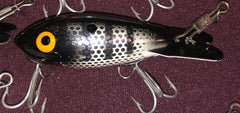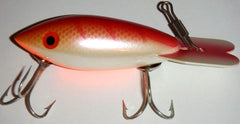Bomber Lures
Bomber Lure Company / Bomber Baits
Bomber Lures and the Bomber Bait Company of Gainesville, Texas. One of my favorite lure companies. Owned by Pradco now and sadly they are not even producing the most iconic bait anymore, the original Bomber. Well here we have them along with some history and so much more. Below are just some quick links to some great Bomber information.
See all of our Bomber Lures for sale here.
In the early 1940's, C.S. (Clarence) "Turby" Turbeville and Ike Walker fished their local Texas lakes and the deep brushy water of Lake Murray in Oklahoma. Their favorite lure was the Creek Chub Crawdad, however they thought the 25 year old lure could be improved upon. The Crawdad in their opinion had an erratic action and didn't dive deep enough for their local lakes. They also experimented with the line tie and lip shapes and realized they could improve upon the design. An idea was born and lifelong partnership was to be formed between these two men from Gainesville, Texas.
Turbeville had graduated from the University of Texas in 1934 with a Bachelor's Degree, a Major in Ecomonics, Double Minor in Government and Business Administration. He returned home to Gainesville and worked at his fathers' music business expanding it into fishing tackle, appliances and soon after butane gas system installation. The appliance and butane gas section of the business really took off and would later be sold off in 1945 along with sporting goods business to help fund the Bomber Bait Company. Turbeville would stay on for one more year full time after selling to help transition the business as he worked the Bomber business at night.
Ike Walker grew up in a small farming community outside of Lubbock Texas. He was an enrollee in the inaugural year of Texas Tech, 1925. He went to college to be a civil engineer but after two weeks changed to agriculture and Graduated with a Degree in Horticulture from Texas Tech in 1930. In 1938 he moved to Gainesville to open a tire repair business. He would stay in this business until 1942. World War 2 had created material shortages and he lacked the resources to acquire them. In 1943 he went to work for a larger tire repair business in town, Western Auto, that did have access to materials and contacts. In the meantime he had started fishing a little and making plugs at home.
These two north Texas fisherman soon set up in a garage used by Ike for his OK Tire and Rubber business and worked nights starting to manufacture their new lure. Their first line ties were cut from Prince Albert Tobacco Tins and diving lips were cut from an old cook stove. White Cedar was turned on a hand lathe and shoe eyes were used for hook hangers. The finished products were all painted black to avoid reflection in the deep waters (colors other than black were not added until after 1946). Soon they had their first prototypes, an early invention, the 'Bomber', a lure that wouldn't snag, even wh
 en dropped deep into the water.
en dropped deep into the water.
By 1944 a small business was set up. Friends began requesting these baits, soon after so did local stores. Their first operation was set up on Main Street in Gainesville with the office at 212 E. California St, Gainesville, Texas They began to use a spray painter and experiment with scale patterns at this time.
In Sept 24, 1945 they applied for a patent on their new lure. (See a copy of the Patent here.)
In 1946 with the war over, the Bomber Bait Co. was incorporated. A German machinist was hired to automate and standardize procedures and the produce the company's first automatic lathe. The Art Wire Stamping Co was contracted to provide the lines ties and lips.
Around 1946 or 1947 the company moved its offices and assembly to 304 1/2 California St. in Gainesville.
A 1947 news article states that the Bomber Bait Company was "already making 1000 bombers a day -- a significant output for a lure that had yet to see national advertising!" and that "New machinery has been invented in Gainesville to speed up the process of manufacture. But it's still mostly hand work, like the eyes, which are of two colors--yellow with a black iris. They're made or painted on with a common nail. A worker dips the head into the yellow ink, applies to the lure, then dips the other end into black ink and dabs it in the center of the yellow."
In November 1951 the business moved to 326 Lindsay St. in Gainesville were it would stay until it was sold to PRADCO in 1988. In 1968 original management company sold to Van Ellis of Dallas. Production of wooden Bombers was discontinued after 1970 and in 1971 wooden Bombers were a thing of the past.

Former Bomber Bait Company Building, Lindsay St, Gainesville, TX in 2008
- 1942 - A small business was set up between C.S. (Clarence) "Turby" Turbeville and Ike Walker making wooden baits for friends and local stores. Their first operation was set up on Main Street in Gainesville with the office at 212 E. California St, Gainesville, Texas.1
- 1945 - Patent applied for what would become the Bomber Lure. See a copy of the patent here.
- 1946 - Bomber Bait Company becomes Incorporated.
- 1947 - Patent granted on the Bomber bait.
- 1951 - November. Business moves to 326 Lindsay St. in Gainvesville, Texas. It would stay at this location until moving to Fort Smith, Arkansas after the PRADCO acquisition.
- 1968 - Business sold to G.C. Morton and his son-in-law Van Ellis. Van Ellis' son, G.C. Ellis is brought in to learn the business. C.S. Turbeville stays on as President. Ike Walker stays on a short time before retiring and moving to Mission, Texas.
- 1971 - All Bombers are now made out of plastic.3
- 1975 - Bucktail Bomber introduced in certain colors (plastic)
- 1984 - August 5th- C.S. Turbeville dies at the age of 72. G.C. Ellis takes over the role of President.
- 1988 - June 23rd - Ike Walker dies at the age of 83.
- 1988 - August - PRADCO purchases the Bomber Bait Company2
Sources:
1: 1981, North Texas University, Oral History Collection, Number 54, Interview with C.S. Turbeville; June 17 (Noted as 1942 or 43 several times).
2: 1988, August 7th: Fort Worth Star-Telegram (Fort Worth, Texas) Page 48
3: 1984, August 12: Fort Worth Star-Telegram (Fort Worth, Texas) Page 62

May 1964 Advertisement for Bomber Lures
What sizes did Bombers come in? You can see below the different size codes and corresponding lengths. Please note unlike some other lures Bombers are measured including the lip.
| BOMBER SIZES | LENGTH* |
| 200 | 2 1/2" |
| 300 | 2 3/4" |
| 400 | 3 1/4" |
| 500 | 3 1/2" |
| 600 | 4" |
| 600HD | 4" |
*overall length including lip
BOMBER FAQ's & FUN FACTS
How do you tell the difference between a wooden and plastic Bomber fishing lure?
On the bottom of the diving lip a wooden Bomber will have a small screw holding it in place. A plastic Bomber will not. The same is true for Waterdog lures.
Where you can purchase original wooden and plastic Bombers?
These original "football" shaped Bombers can be purchased right here at MyBaitShop.com
Do you know what year the first plastic Bombers were made?
1949. They were first produced in 1949 with a heavily reinforced lip. This was the only year they were made in this manner. They are affectionately referred to as "49ers" by collectors.
Is there a place I can see all of the colors of Bomber lures ever made?
Yes, in fact there is. At MyBaitShop.com we are working with some of the best Bomber collectors in the world to put together a master color chart of all of the cataloged and uncatalogued colors of Bombers that we can find.
See all of our Bomber Lures for sale here.
BOMBER COLOR CHART
Bomber Lures were made in so many great colors. Colors to catch fish and some colors to catch fisherman. Either way, so many great colors available. You can see why Bombers were and still are so popular. We have examples linked to show the colors of the Bomber lures we had available to us. We've got the world's biggest Bomber Color Chart below and we will continue to add more over time.
Did you know? Bomber Baits holds more State Bass Records than any other bait despite not being made for years. The original (football shaped) Bombers hold more Largemouth and Smallmouth state bass records than any other bait. Pretty amazing accomplishment if you ask me.
One of the coolest things about collecting old fishing lures is looking back at some of the old advertisements. You find them in different magazines, catalogs, online archives etc. It's a look back into a different era of time in our country and really brings out the nostalgia of these little pieces of wood of metal.
One of the things that really stands out to me about the Bomber Bait Company is their Christmas ads. Some companies have one here and there but for a period of time in the 1950's and 1960's it seems like almost every year Bomber came out with a Christmas ad. I am guessing it was probably every year for about 15-20 years but I haven't tracked them all down yet. Below are the ones I have found. If you can help ad to these, please let me know. I hope you enjoy these as much as I do.
| 1954 |  |
| 1955 |  |
| 1956 |  |
| 1957 |  |
| 1963 |  |
| 1964 |  |
| Unknown |  |
Bomber Lures, makers of the Fat Free Shad, Model A, Long A and other fish-catching baits, began with an idea – a lure that dives deep, fishes quickly and comes through the thick wood cover of emerging Texas reservoirs. Today Bomber Lures produces tournament-winning crankbaits and other lures that lead the industry. Bass, walleyes, stripers, northern pike and other gamefish all know the power of the Bomber!
Do you have stories, memories, photos or other items about the Bomber Bait Company and it's history you would like to share? Contact us and let us know. We would be happy to add your memories and information to this page.
Sources / Credits:
The Bomber Bait Company by Jim Bourdon 1983
Bomber Bait Company catalogs
A huge thanks to Blake Taylor. Without his help a lot of this information and images would not be available.
Thanks to Darwin Stewart for use of images and resource material.
North Texas University, Oral History Collection, Number 54, Interview with C.S. Turbeville; June 17, 1981
North Texas University, Oral History Collection, Number 65, Interview with Ike Walker; September 16, 1981























































































































































